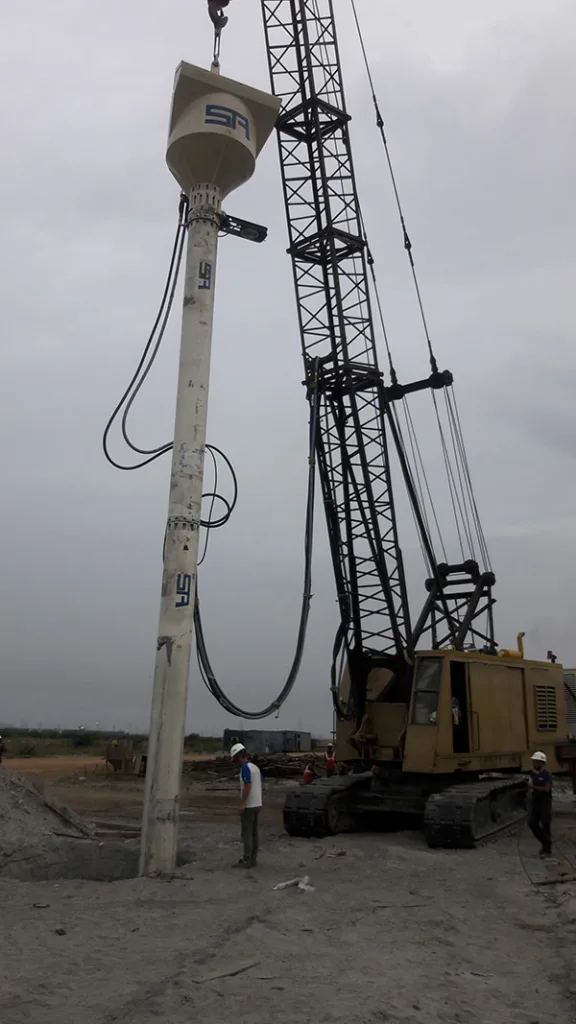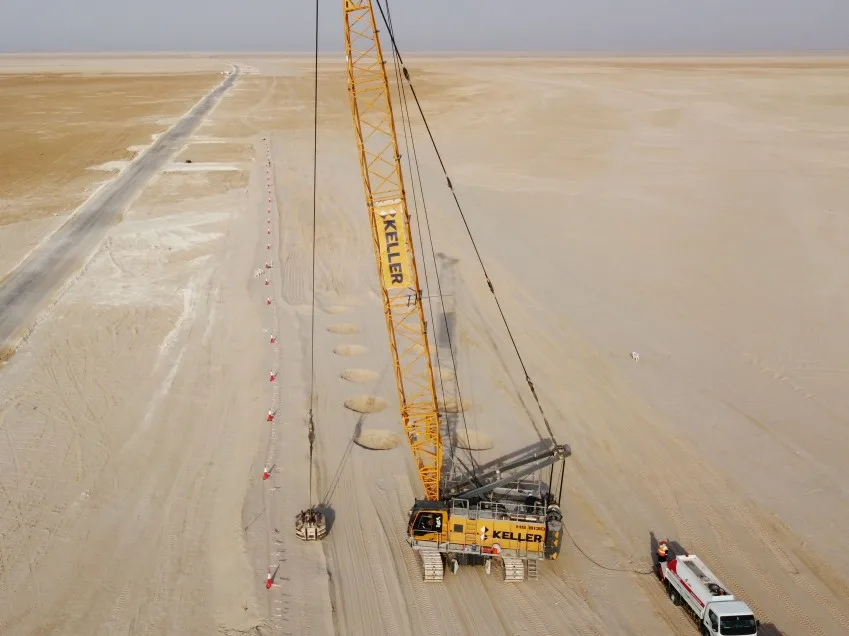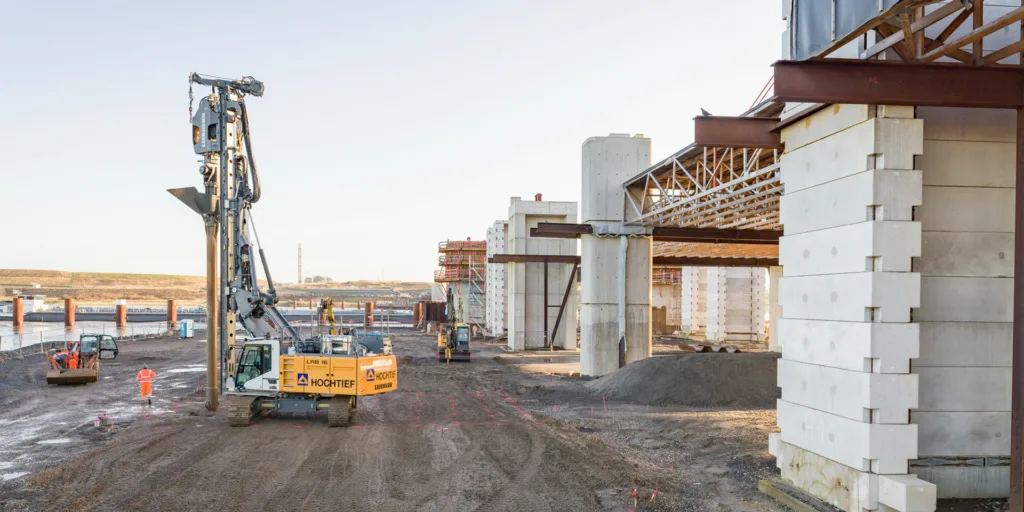Vibro compaction also known as Vibroflotation is a ground improvement method used for stabilising and compacting deep layers of non-cohesive soils. This process uses vibrating probes that are inserted into the soil, creating dynamic compaction. The vibrations reduce the void spaces between soil particles, allowing for increased soil density and improved load-bearing capacity.
Vibco Compaction Method
The process typically involves inserting a vibrator, often in the form of a probe, into the ground to the desired depth. The vibrator is then activated, causing the surrounding soil to densify. The method typically includes:
1. Probe Insertion: Vibratory probes are inserted vertically into the ground at predetermined locations.

2. Vibration: The probes vibrate, transmitting energy into the surrounding soil, causing it to densify.The vibrations reduce the void spaces between soil particles.

3. Lift and Drop: The probes may be lifted and dropped several times to enhance compaction.

4. Progressive Compaction: The process is repeated systematically across the entire area, progressing in a grid pattern until the desired compaction level is achieved.
Why is the Vibro Compaction method used?
Vibro compaction is commonly used in areas with loose sands, silts, or other granular soils, the method is used because;
- Improves soil density by using vibrations to rearrange soil particles, reducing voids and increasing overall compaction.
- By breaking down the soil structure through vibrations, the method compacts the soil, reducing its overall volume and increasing its density.
- Enhances the shear strength of the soil, making it more resistant to deformation and improving its overall stability.
- Improves the soil’s load-bearing capacity, making it suitable for supporting various structures like buildings, bridges, or other infrastructure.
- Densifies soil for enhanced load-bearing capacity, important for supporting heavy structures.
- Minimizes settlement in loose soils, decreasing potential for uneven subsidence over time.
- Makes soil less susceptible to liquefaction during seismic events, vital in earthquake-prone areas.
- Helps prevent horizontal movement of soil during seismic activity.
Different Methods for Vibro Compaction
Depth Vibro Compaction:
Depth vibro compaction is a ground improvement method that involves the use of a vibroflot, a cylindrical vibrating probe, to densify loose granular soils at various depths beneath the ground surface. The vibroflot is inserted vertically into the soil, and as it vibrates, the surrounding soil particles rearrange and settle, increasing overall soil density. This method is effective for improving the load-bearing capacity and reducing settlement in areas with loose or poorly compacted soils.
Surface Vibro Compaction:
Surface vibro compaction focuses on improving near-surface soil layers by applying horizontal vibrations at the ground surface using a vibroflot. This method is particularly useful for addressing shallow soil-related issues, such as liquefaction potential or uneven settlement. By compacting the upper layers, surface vibro compaction enhances the overall stability of the ground, making it suitable for construction projects where surface soil quality is important.
Wet Top Feed Vibro Compaction:
In wet top feed vibro compaction, water or slurry is added to the ground surface during the compaction process. This added moisture can aid in the compaction of soil particles, facilitating better densification. The wet top feed approach is beneficial when dealing with soils that have a higher degree of cohesion or when additional moisture content is needed to achieve the desired compaction results.
Dry Top Feed Vibro Compaction:
In contrast to wet top feed, dry top feed vibro compaction involves the application of a dry granular material at the ground surface without the addition of water or slurry during the compaction process. This method is suitable for soils that already have adequate moisture content or when the introduction of additional water may be undesirable for the project’s requirements.
Different equipments used for Vibro Compaction
Vibro Floatation Rigs:
Vibro floatation rigs are specialized construction equipment designed for ground improvement in areas with loose or soft soils. These rigs feature vibrating mechanisms capable of inducing soil liquefaction, a process that temporarily transforms the soil into a more fluid-like state. By adjusting the intensity of the vibrations, these rigs effectively densify the soil, enhancing its bearing capacity. This makes them particularly valuable for preparing sites where traditional foundation methods may be inadequate. Vibro floatation rigs contribute to stabilizing the ground and preventing issues like settlement, ensuring a more secure foundation for structures such as buildings and bridges.

Deep Vibratory Compactors:
Deep vibratory compactors are heavy-duty machines equipped with vibrating plates or probes designed to penetrate deeply into the ground. These compactors utilize variable frequency and amplitude settings to achieve optimal compaction. Their primary function is to densify soil layers, reducing settlement and increasing load-bearing capacity. This makes them essential in construction projects where a stable foundation is important. Deep vibratory compactors excel in preparing sites with loose or variable soil conditions, providing an effective solution for ensuring the long-term stability and performance of structures.

Compaction Rigs:
Compaction rigs are specialised equipment essential in the soil improvement process. These rigs, equipped with vibratory rollers and variable frequency control mechanisms, play a important role in enhancing soil density and stability. Operating with precision, they enable controlled compaction in targeted areas, ensuring uniform improvement throughout the construction site. Advanced monitoring systems provide real-time data on soil density, allowing operators to make necessary adjustments for optimal results. The adaptability of these rigs to diverse soil conditions and project requirements makes them indispensable in foundation construction and various infrastructure projects.

Vibro Replacement Rigs:
Vibro replacement rigs, also known as stone column rigs, employ vibratory probes to displace and compact surrounding soil while simultaneously introducing granular material. These rigs are particularly valuable in areas with weak or compressible soils. The vibratory action of the probes enhances the load-bearing capacity of the ground, creating a composite ground structure. The introduced granular material further reinforces the soil, improving drainage and overall stability. Vibro replacement rigs are commonly used to address challenging soil conditions, providing an effective solution for ground improvement in areas where traditional foundation methods may be insufficient.

How to select right equipment for Vibro Compaction?
– Conduct thorough soil analysis for composition, density, and cohesion.
- Assess project size and scope to determine suitable equipment capacity.
- Evaluate required compaction depth and select equipment accordingly.
- Consult geotechnical engineers for expert advice on soil characteristics.
- Consider site accessibility and choose equipment compatible with constraints.
- Perform a cost-benefit analysis, balancing upfront costs with long-term efficiency.
- Ensure availability of maintenance support and spare parts for chosen equipment.
Applications of the Vibro Compaction Method
- Foundation Stabilization
- Road and Embankment Construction
- Port and Harbor Construction
- Land Reclamation Projects
- Airport Runway Construction
- Storage Tank Foundations
- Pipeline Trench Backfilling
- Railway Track Bed Stabilization
Conclusion
Vibro compaction is a cost-efficient and time-saving method used for solid foundations enabling long-term structure durability. Selecting the appropriate equipment for specific soil conditions and project requirements is important for the method. As technology continues to advance, ongoing innovation in vibro compaction equipment holds the promise of further improving construction practices.
Image Source: suretech.co.in, menard-asia.com, kellerindia.com, liebherr.com


